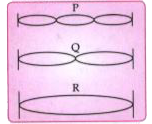Can an object vibrating transversely produce a sound wave ? Explain.
Step-by-Step Solution:
1. Understanding Transverse Vibration:
- Transverse vibration occurs when an object moves up and down or side to side, perpendicular to the direction of wave propagation. An example of this is a guitar string when it is plucked.
2. Sound Wave Production:
- Sound waves are mechanical waves that require a medium (solid, liquid, or gas) to travel through. They are typically longitudinal waves, where the particle displacement is parallel to the direction of wave propagation. However, transverse vibrations can still lead to sound wave production.
3. Example of a Guitar:
- When a guitar string is plucked, it vibrates transversely. The movement of the string creates disturbances in the surrounding air, which leads to the formation of sound waves. The string moves up and down, while the sound waves propagate through the air.
4. Conclusion:
- Therefore, an object vibrating transversely can indeed produce sound waves, as demonstrated by the example of a guitar string. The transverse motion of the string generates pressure variations in the air, which we perceive as sound.
Final Answer:
Yes, an object vibrating transversely can produce a sound wave, as exemplified by the vibration of guitar strings.
---
- Transverse vibration occurs when an object moves up and down or side to side, perpendicular to the direction of wave propagation. An example of this is a guitar string when it is plucked.
- Sound waves are mechanical waves that require a medium (solid, liquid, or gas) to travel through. They are typically longitudinal waves, where the particle displacement is parallel to the direction of wave propagation. However, transverse vibrations can still lead to sound wave production.
- When a guitar string is plucked, it vibrates transversely. The movement of the string creates disturbances in the surrounding air, which leads to the formation of sound waves. The string moves up and down, while the sound waves propagate through the air.
- Therefore, an object vibrating transversely can indeed produce sound waves, as demonstrated by the example of a guitar string. The transverse motion of the string generates pressure variations in the air, which we perceive as sound.
Yes, an object vibrating transversely can produce a sound wave, as exemplified by the vibration of guitar strings.
Topper's Solved these Questions
- WAVESBOOK - ICSECHAPTER - WAVESEXERCISE - Musical Sound
2 Videos
- WAVESBOOK - ICSECHAPTER - WAVESEXERCISE - Conceptual Short Answer Questions With Answers
25 Videos
- WAVESBOOK - ICSECHAPTER - WAVESEXERCISE - Additional Solved Problems
13 Videos
- VECTORS SCALARS ELEMENTARY CALCULUS BOOK - ICSECHAPTER - VECTORS SCALARS ELEMENTARY CALCULUS EXERCISE - UNSOLVED PROBLEMS
79 Videos
Similar Questions
Knowledge Check
A transverse wave consists of
Aonly crestsBonly troughsCboth crests and troughsDrarefactions and compressions
Standing waves can be produced
View SolutionThe diagram below shows three different modes of vibration P, Q and R of the same string of a given length.

Which vibration will produce a louder sound and why?
View SolutionOur ear can hear the frequency of sound waves
View SolutionThe adjacent diagram shows three different modes of vibrations P, Q and R of the same string.

Which vibration will produce a louder sound and why?
View SolutionWhich frequency produces a sound that can be heard by a person?
View SolutionIs it possible to produce longitudinal wave and transverse wave in the same medium? Explain with an example.
View SolutionIn case of a transverses wave in a string
View Solution
